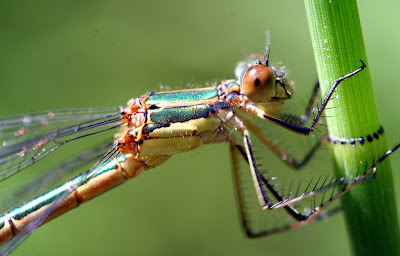 It seems to me nothing man has done or built on this land is an improvement over what was here before.
It seems to me nothing man has done or built on this land is an improvement over what was here before.An example of one such place, land that hasn't ever been tilled for agriculture or improved in some way for development, lies halfway between Chicago and Milwaukee. A genuine tallgrass prairie, the Chiwaukee offers a delightful mix of native grasses, uncommon sedges and drop-dead gorgeous orchids among the many wildflowers that bloom within its swells and swales.
It's an excellent place to test your plant identification skills. I was fortunate to have a botanist and walking-encyclopedia along with me to identify plants. I'd point and Jim would spit out a Latin name. Kinda Pavlovian and fun.
;-)
I was tickled to spot this beauty first, after he walked right past it.
The Prairie White Fringed Orchid is a federally threatened speci
 es and like most orchids, rather mysterious in its growing habits... some years there's lots, others not so many. We found just two, I think, on the small portion of the Chiwaukee's 225 acres that we walked through.
es and like most orchids, rather mysterious in its growing habits... some years there's lots, others not so many. We found just two, I think, on the small portion of the Chiwaukee's 225 acres that we walked through.Swaying back and forth among the grasses... delicate and exquisite... and tall at about three feet, it was easy for me to see why there are volunteers sufficiently enthralled with this particular orchid to stand in for their hawkmoth benefactors and pollinate them by hand, with toothpicks, at various sites within their range. So beautiful were they that I hardly saw any of the other wildflowers that surrounded them.
Pristine as it may be, the Chiwaukee and all its wonders are surrounded by houses and sprawl and represents just a small fragment of the native prairie that once existed in that part of the country.
It's hard for me to imagine anyone plowing these under to grow corn or soybeans or heaven-forbid-Walmarts, but that's not my reality. Far removed, I see only the interplay between an ancient prairie threatened by people, even as it's watched over and appreciated by others.





























.JPG)
.JPG)

